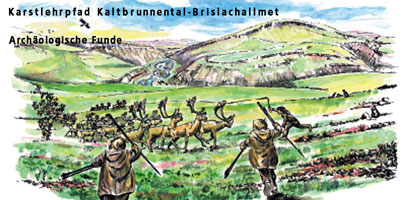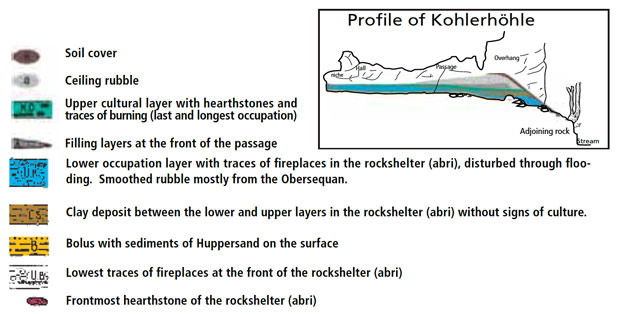Cave dwellers?
The Kohlerhöhle and Heidenküche are two typical examples of the many Stone Age settlements in the Birstal. The image of ‘cave-dweller’ is based on 19th century ideas of cultural history and is unlikely to represent the prehistoric way of life. Rather than living in the narrow confines of caves, prehistoric people settled mostly in the open air throughout this period, regardless of the prevailing climate. They lived by hunting and gathering edible plants. They hunted not only large animals such as wild horses and reindeer, but also smaller prey including wildfowl or hares, which formed a large part of their food supply.
Kohlerhöhle
The Kohlerhöhle is 18m long and is situated in an easily visible horizontal cleft. It is the lowest of three caves situated one on top of the other, which indicates that the course of the Ibach changed levels three times. The archaeologists discovered an older and a more recent layer of finds. New radiocarbon (14C) dating estimates the age of the older layer as at least 23-24’000 years, a time when the Swiss midlands were still largely covered by glaciers. The younger layer contains faint traces of human occupation from about 19’500 years ago, but mostly from the late Magdalenian, 16’000 to 14’500, and, to a lesser degree of the late palaeolithic period about 13’500 years ago. The finds from the late Magdalenian are composed of food waste (animal bones), stone tools to work animal skins and antlers, parts of hunting weapons, sewing needles, pieces of jewellery fashioned from animal teeth and also fossilised mussels and snails from the area around Mainz.
Heidenküche
Already in 1883 John Benedikt Thiessing discovered the first stone tools. Sporadic excavations took place until 1906. As far as can be seen from the finds kept in a number of museums, Heidenküche was in use during the recent phase of the Kohlerhöhle. Heidenküche belongs to the first early Stone Age archaeological sites discovered in Switzerland (Kesslerloch near Schaffhausen in 1873, the cave near Liesberg in 1874). In 1864, a piece of tusk engraved with image of a mammoth was discovered in ‘La Madelaine’ proving that prehistoric man was a contemporary of these now extinct animals.
You can find additional interesting information in the Museum Laufental.


